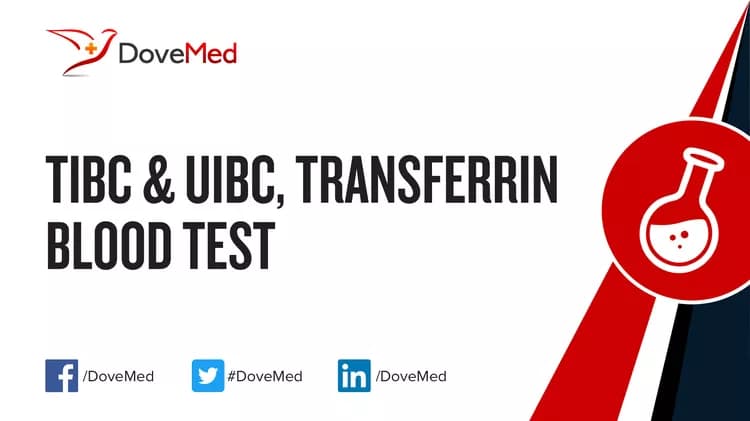What are the other Names for this Test? (Equivalent Terms)
- IBC Blood Test
- Iron Binding Capacity Blood Test
- Siderophilin Blood Test
What is TIBC & UIBC, Transferrin Blood Test? (Background Information)
- Ionic iron, Fe2+, is a needed for proper red blood cells (RBCs) function. RBCs primarily transport oxygen from the lungs, to the rest of the body
- Freely dissolved Fe2+ is very toxic. Virtually no Fe2+ floats around in blood; instead, iron is bound by proteins, such as ferritin, transferrin, and hemoglobin
- Ferritin is found inside cells and provides in-cell storage of iron
- Transferrin migrates through blood and transports iron, between body sites
- Other carrier proteins exist, but transferrin carries up to 70% of the iron in blood
- Total iron binding capacity (TIBC) refers to the total amount of iron being carried through blood. Though proteins other than transferrin contribute to TIBC, TIBC is often used interchangeably with transferrin
- Unlike ferritin and transferrin, hemoglobin (Hb) is more than a storage or carrier for iron. Hb is an oxygen-carrying protein comprising 96% of the dry weight of RBCs. Iron is at the center of hemoglobin function
- Iron provides structural support to hemoglobin. More importantly, however, it facilitates the change in structure that accompanies binding of oxygen by hemoglobin. This structural change allows further binding of oxygen to occur more easily, a trait termed cooperativity
- The cooperativity allowed by iron in Hb is important to RBC’s ability to oxygenate tissues, because it allows for small changes in oxygen levels to have a large effect on RBCs’ binding effectiveness. In other words, it makes the process more like an ‘on/off’ switch and less like a dimmer switch
- The Total Iron Binding Capacity (TIBC), Unsaturated Iron Binding Capacity (UIBC), and Transferrin Tests are blood tests to assess an individual’s iron levels and their ability to transport iron throughout their body
- Serum Iron Test - measures levels of dissolved Fe2+ in blood plasma
- Total Iron Binding Capacity (TIBC) Test - measures the levels of transferrin bound with iron
- Unsaturated Iron Binding Capacity (UIBC) Test - measures levels of transferrin that has not bound iron
- Iron Saturation - measures the percentage of iron bound to transferrin. It is calculated by dividing the serum iron value by the TIBC value, and multiplying by 100. An inverse of this value indicates the transferrin saturation
What are the Clinical Indications for performing the TIBC & UIBC, Transferrin Blood Test?
Following are the clinical indications for performing the Total Iron Binding Capacity (TIBC), Unsaturated Iron Binding Capacity (UIBC), and Transferrin Blood Tests:
- Testing for anemia, which is marked by:
- Fatigue
- Pale skin
- Dizziness
- Shortness of breath
- Testing for iron toxicity, which is marked by:
- Heart abnormalities
- Joint pain
- Loss of libido
- Nausea and vomiting
- Abdominal pain
- Differentiating between iron-deficiency anemia and anemia, secondary to chronic disease
- As a follow-up to other iron tests
How is the Specimen Collected for TIBC & UIBC, Transferrin Blood Test?
Following is the specimen collection process for Total Iron Binding Capacity (TIBC), Unsaturated Iron Binding Capacity (UIBC), and Transferrin Blood Test:
Sample required: Blood
Process: Insertion of a needle into an arm vein.
Preparation required: No special preparation is needed prior to the test.
What is the Significance of the TIBC & UIBC, Transferrin Blood Test Result?
The significance of Total Iron Binding Capacity (TIBC), Unsaturated Iron Binding Capacity (UIBC), and Transferrin Blood Test is explained:
Elevated serum iron may indicate:
- Iron toxicity
- Hemolytic anemia
- Sideroblastic anemia
- Hemochromatosis
Decreased serum iron may indicate:
- Iron deficiency in the diet
- Inability to absorb iron
- Chronic infection or illness
Elevated total iron binding capacity (TIBC) may indicate:
- Iron deficiency in the diet
- Inability to absorb iron
Decreased total iron binding capacity (TIBC) may indicate:
- Hemochromatosis
- Chronic infection or illness
Elevated unsaturated iron binding capacity (UIBC) may indicate:
- Iron deficiency in the diet
- Inability to absorb iron
Decreased unsaturated iron binding capacity (UIBC) may indicate:
- Hemochromatosis
- Chronic infection or illness
- Hemolytic anemia
- Sideroblastic anemia
- Iron toxicity
Elevated transferrin saturation may indicate:
- Hemochromatosis
- Hemolytic anemia
- Sideroblastic anemia
- Iron toxicity
Decreased transferrin saturation may indicate:
- Iron deficiency in the diet
- Inability to absorb iron
- Chronic infection or illness
The laboratory test results are NOT to be interpreted as results of a "stand-alone" test. The test results have to be interpreted after correlating with suitable clinical findings and additional supplemental tests/information. Your healthcare providers will explain the meaning of your tests results, based on the overall clinical scenario.
Additional and Relevant Useful Information:
- Only about 10% of dietary iron is actually absorbed in the body
- Due to the body’s ability to store iron, supplementation with iron may result in iron overload and toxicity
- Foods rich in iron include - red meats, egg yolks, liver, and dark green vegetables
Certain medications that you may be currently taking may influence the outcome of the test. Hence, it is important to inform your healthcare provider, the complete list of medications (including any herbal supplements) you are currently taking. This will help the healthcare provider interpret your test results more accurately and avoid unnecessary chances of a misdiagnosis.
Related Articles
Test Your Knowledge
Asked by users
Related Centers
Related Specialties
Related Physicians
Related Procedures
Related Resources
Join DoveHubs
and connect with fellow professionals


0 Comments
Please log in to post a comment.